Hawaiian Shoyu Chicken
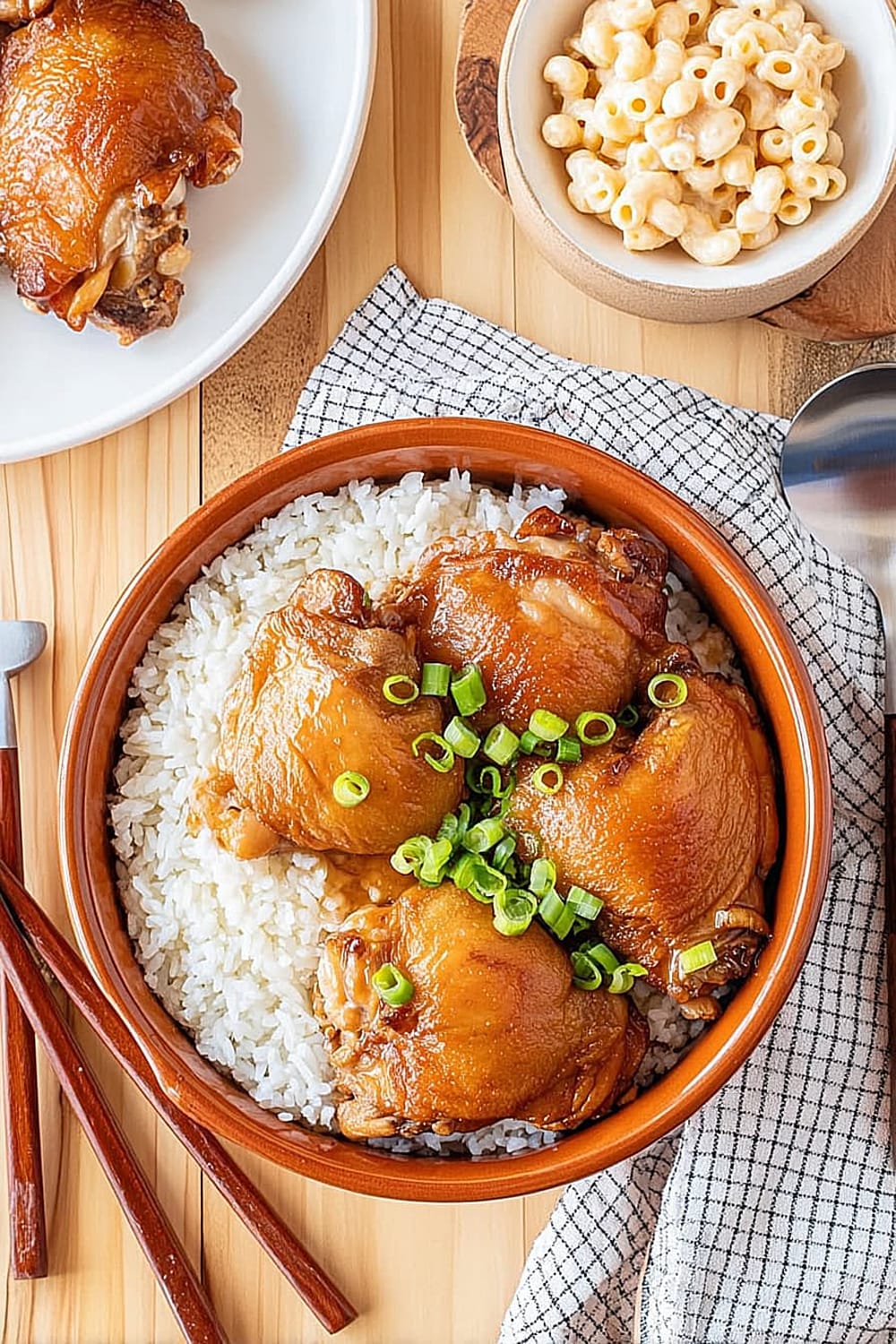
This recipe transforms humble chicken thighs into something so ridiculously flavorful that people will assume you’ve been secretly taking cooking classes.
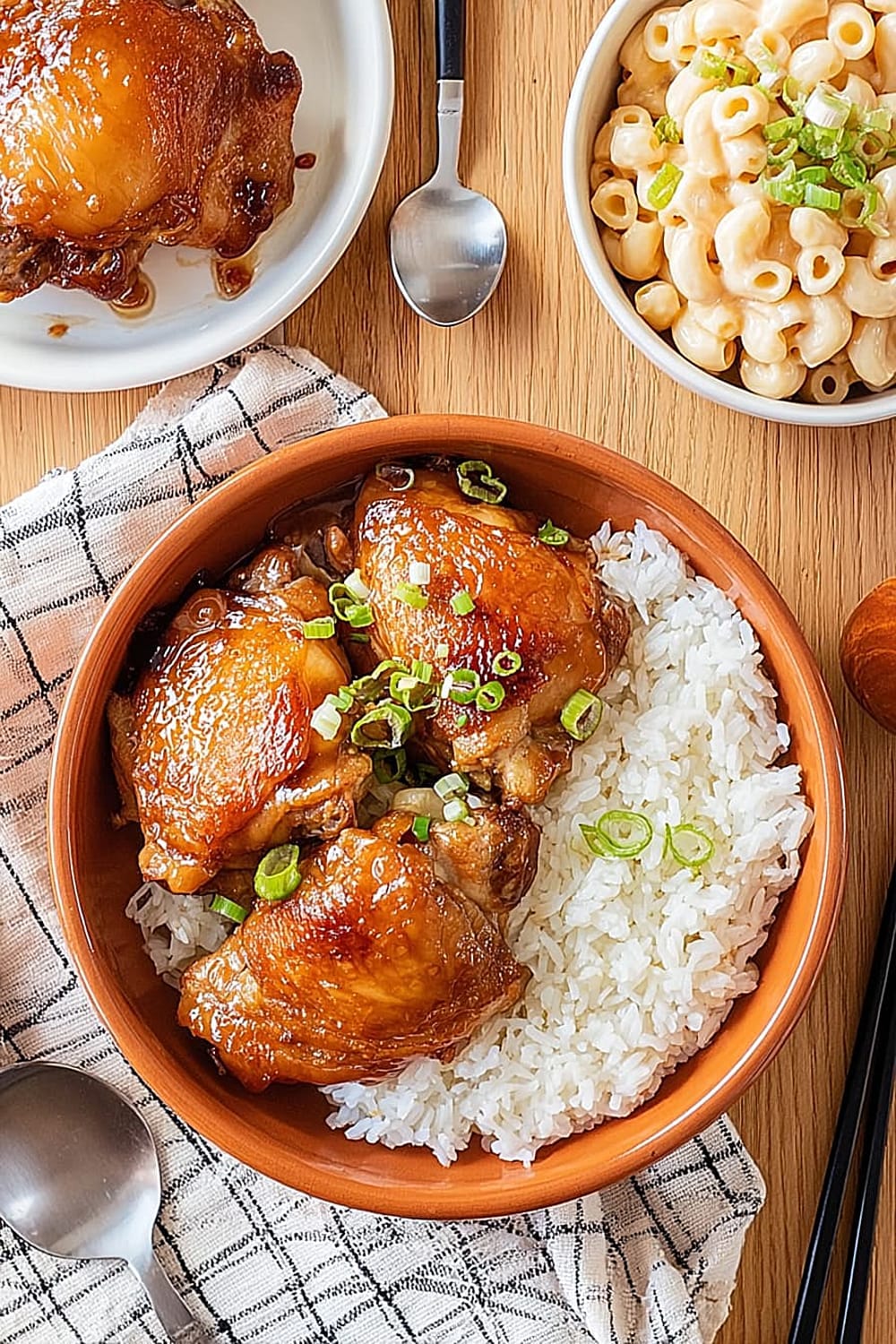
The magic happens when shoyu meets brown sugar and mirin, creating a glossy, umami-packed sauce that makes everything taste like it came from your favorite Hawaiian plate lunch spot.

What makes this recipe absolutely genius is how the chicken literally braises in its own delicious sauce, getting more tender and flavorful with every passing minute.

The aroma alone will have your neighbors suddenly finding excuses to drop by unannounced – consider this your official warning.

This is the kind of one-pot wonder that looks fancy enough for company but requires zero fancy techniques or hard-to-find ingredients.

Prepare yourself for the ultimate compliment: “Wait, you actually made this?” followed by immediate requests for the recipe.
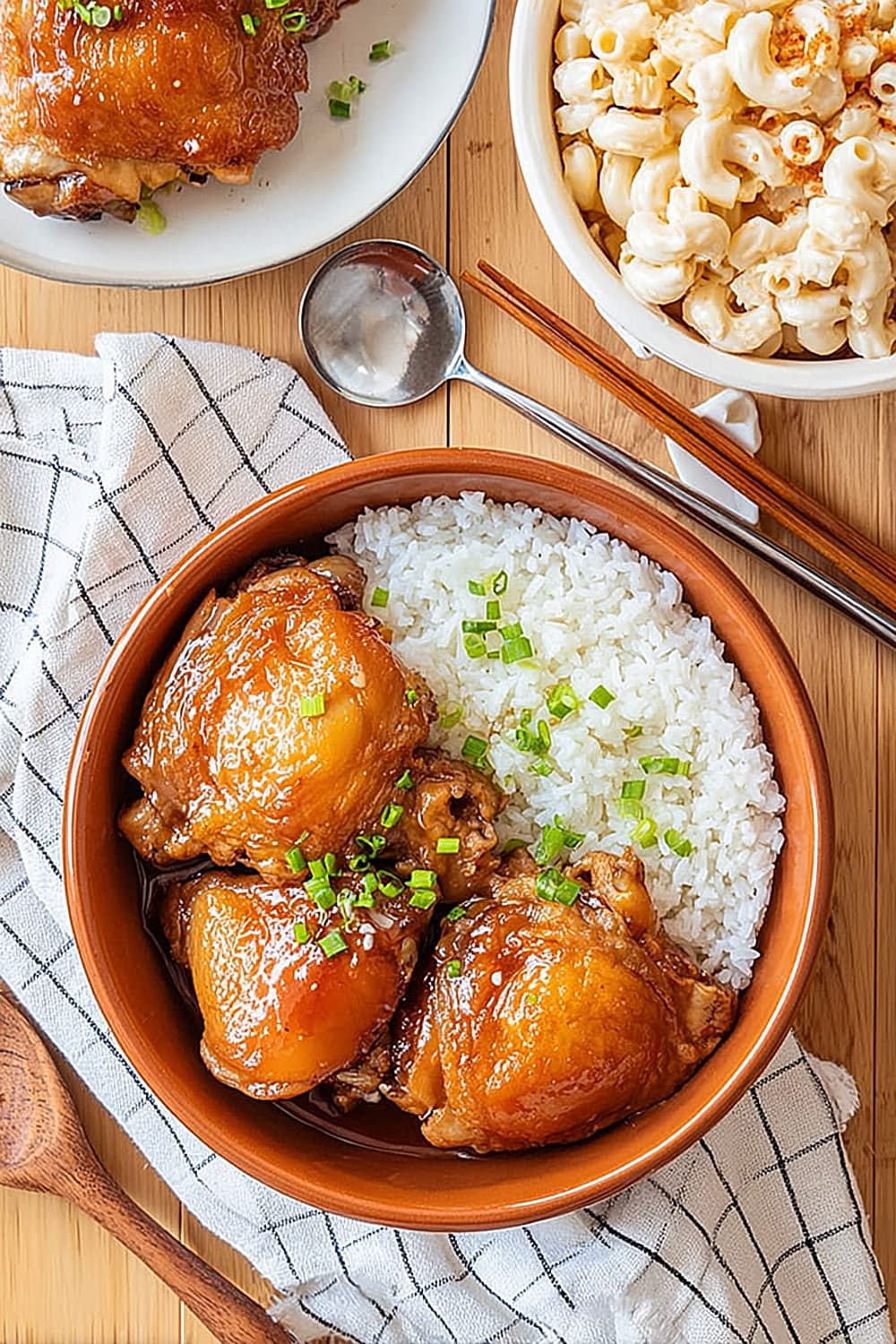
Ingredients

For the Shoyu Braising Sauce:
- 1 cup water
- 3/4 cup shoyu (soy sauce)
- 1/4 cup packed light brown sugar
- 1/4 cup mirin
- 1/4 teaspoon freshly ground black pepper
For the Aromatics:
- 4 cloves garlic, peeled
- 1 (3-inch) piece fresh ginger
- 4 medium scallions
For the Main Dish:
- 8 bone-in, skin-on chicken thighs
- Cooked white rice, preferably short grain, for serving
Instructions

Prepare the Braising Base:
- Place 1 cup water, 3/4 cup shoyu (soy sauce), 1/4 cup packed light brown sugar, 1/4 cup mirin, and 1/4 teaspoon black pepper in a large Dutch oven or heavy-bottomed pot. The Dutch oven is crucial here because it distributes heat evenly and prevents hot spots that could burn your precious sauce.
- Bring the mixture to a simmer over medium-high heat, stirring constantly until the brown sugar completely dissolves, about 2-3 minutes. You’ll know it’s ready when the liquid looks glossy and uniform with no sugar granules visible on your whisk.
Prepare the Aromatics:
- While the sauce heats, prepare your aromatics and add each to the pot as you complete it. First, peel 4 garlic cloves and add them whole to the simmering sauce – they’ll infuse their flavor gradually without overwhelming the dish.
- Take the 3-inch piece of fresh ginger and smash it with the flat side of a chef’s knife until it’s lightly crushed but still in one piece. This technique releases maximum flavor while keeping the ginger easy to remove later. Add the smashed ginger to the pot.
- Halve 4 medium scallions crosswise, using both the white and light green parts. The scallions will add a subtle onion flavor that complements the salty-sweet profile perfectly.
Braise the Chicken:
- Add 8 bone-in, skin-on chicken thighs to the pot skin-side down in an even layer. Don’t worry if they overlap slightly – they’ll shrink as they cook. The skin-side down positioning is critical because it allows the skin to render its fat into the braising liquid.
- Cover the pot and reduce heat to medium-low. Simmer for exactly 30 minutes without lifting the lid. This first phase allows the chicken to cook through while the skin renders and flavors meld.
Finish and Glaze:
- Uncover and carefully flip each chicken thigh so they’re skin-side up, arranging them in a single layer if possible. The skin will look pale at this point, but don’t worry – the magic is about to happen.
- Adjust the heat as needed to maintain a gentle simmer where the sauce bubbles actively between the chicken pieces but doesn’t bubble up and over them. This precise temperature control prevents the sauce from reducing too quickly while allowing it to concentrate and glaze the chicken.
- Simmer uncovered for an additional 30 minutes until the chicken is fork-tender and the sauce has reduced to a glossy glaze. The internal temperature should reach 165°F (74°C) when measured with an instant-read thermometer.
Serve:
- Transfer the chicken to a serving platter using tongs, being careful to keep the beautiful glazed skin intact. If desired, use a spoon to skim any excess fat from the surface of the remaining sauce – though a little fat adds richness and authentic flavor.
- Serve immediately with the reduced sauce spooned over the chicken and plenty of cooked short-grain white rice on the side to soak up every drop of that incredible braising liquid.
Recommended Equipment and Kitchen Tools
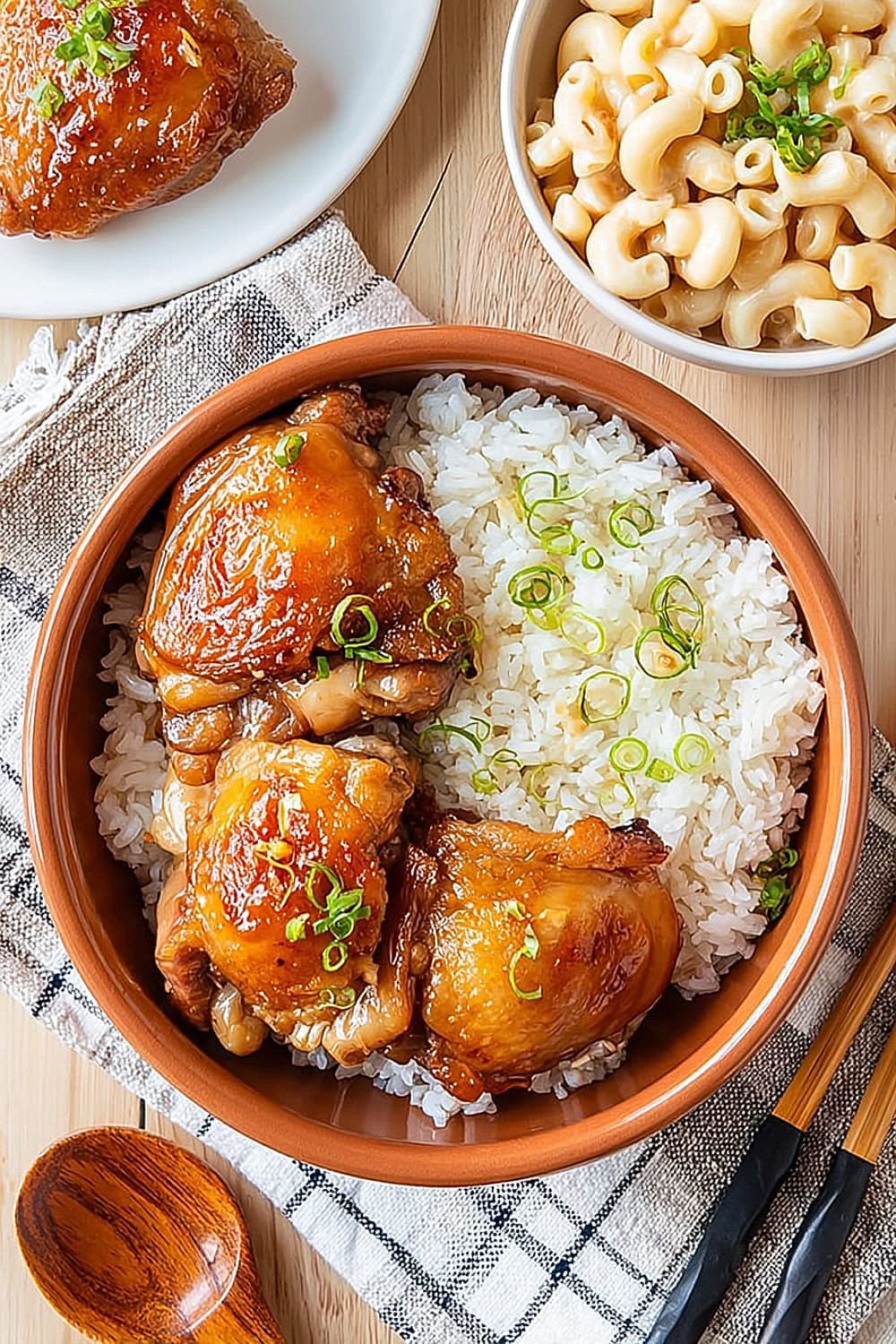
These tools will make your shoyu chicken experience smoother, but don’t stress if you don’t have everything – good cooking is about technique, not fancy equipment.
Recommended Tools (for best results):
- Dutch oven or heavy-bottomed pot – Essential for even heat distribution and preventing the sugar in your sauce from burning. Cast iron works beautifully here.
- Instant-read thermometer – Takes the guesswork out of checking doneness, especially important when cooking bone-in thighs to the perfect 165°F (74°C)
- Long-handled wooden spoon – Perfect for stirring the braising liquid without scratching your pot’s surface
- Kitchen tongs – Makes flipping and transferring the chicken much easier while keeping the skin intact
Helpful Upgrades:
- Digital kitchen scale – For measuring ingredients by weight, which is more accurate than volume measurements for consistent results
- Fine-mesh strainer – If you prefer a completely smooth sauce, strain out the aromatics before serving
- Silicone spatula – Great for scraping up every bit of that precious glazed sauce from the pot
Nice-to-Have Options:
- Microplane grater – If you prefer to grate fresh ginger instead of smashing it, though smashing actually works better for this braising method
- Storage containers – This recipe makes excellent leftovers and reheats beautifully for meal prep
Recipe Variations and Dietary Modifications

Gluten-Free Adaptation:
- Replace shoyu with tamari or coconut aminos in the same 3/4 cup measurement
- Tamari provides the closest flavor match to traditional shoyu
- Coconut aminos offer a slightly sweeter, less salty profile that works beautifully with the brown sugar
Low-Sodium Version:
- Use low-sodium soy sauce and reduce the amount to 1/2 cup, adding 1/4 cup additional water
- Increase the mirin to 1/3 cup to maintain the sweet-savory balance
- Add 1 tablespoon rice vinegar for extra depth
Spicy Variation:
- Add 1-2 dried chilies or 1 teaspoon red pepper flakes to the braising liquid
- Include 1 tablespoon gochujang mixed into the sauce for Korean-Hawaiian fusion
- Fresh sliced jalapeños added in the last 10 minutes provide heat without overwhelming the dish
Weeknight Quick Version:
- Use boneless thighs and reduce total cooking time to 35-40 minutes
- Cut ginger into thin slices instead of smashing for faster flavor release
- Increase heat slightly to medium for more active bubbling and faster reduction
Flavor Variations:
- Pineapple Shoyu: Add 1/2 cup pineapple juice and reduce water to 1/2 cup
- Citrus Twist: Include 2 tablespoons orange juice and 1 teaspoon orange zest
- Sesame Enhancement: Finish with 1 tablespoon toasted sesame oil stirred into the final sauce
Nutritional Information and Health Benefits
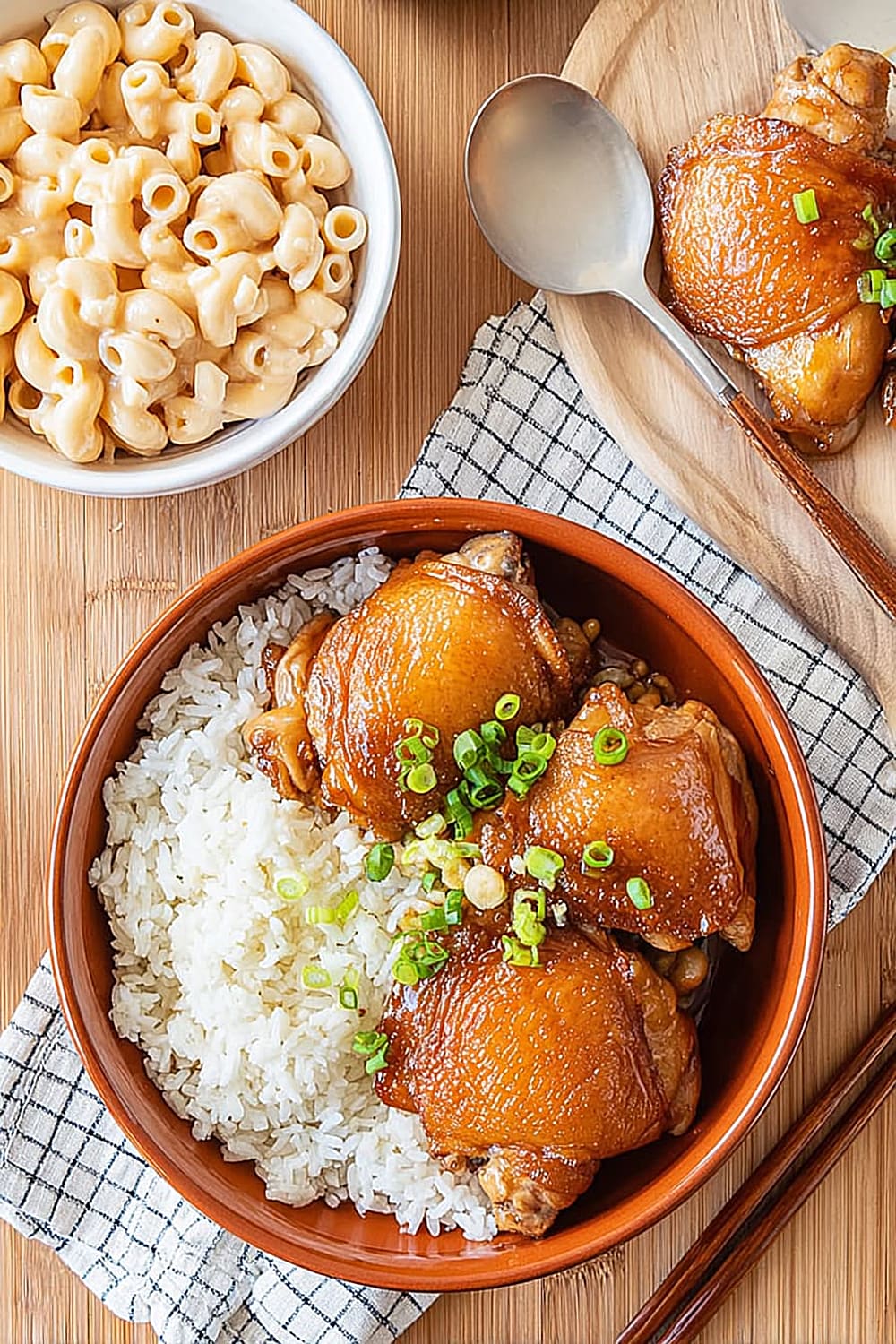
Key Nutritional Highlights:
Each serving provides approximately 320-380 calories, with the majority coming from high-quality protein from the chicken thighs. The bone-in, skin-on preparation provides about 28-32 grams of protein per serving, making this an excellent choice for muscle maintenance and satiety. The braising method allows much of the skin’s fat to render out, reducing overall calories while maintaining flavor.
Health Benefits of Main Ingredients:
The fresh ginger provides powerful anti-inflammatory compounds called gingerols, which may help reduce muscle soreness and support digestive health. Garlic contributes allicin, a compound with potential cardiovascular benefits and immune system support. The scallions offer vitamin K for bone health and vitamin C for antioxidant protection. Chicken thighs provide complete protein plus important minerals like selenium and phosphorus.
Dietary Considerations:
This recipe is naturally gluten-free when made with tamari instead of traditional soy sauce. It’s also dairy-free and fits well into paleo and keto dietary patterns when served with cauliflower rice instead of white rice. The sodium content is moderate at approximately 800-900mg per serving, primarily from the shoyu. Those watching sodium intake can use the low-sodium variation above.
Smart Swaps and Ingredient Substitutions

Common Substitutions:
- Shoyu/Soy Sauce → Tamari (1:1 ratio) for gluten-free, or coconut aminos (use 1 cup instead of 3/4 cup for similar saltiness)
- Mirin → 2 tablespoons rice vinegar + 2 tablespoons sugar, or dry sherry + 1 teaspoon sugar
- Brown sugar → Coconut sugar or maple syrup (use 3 tablespoons syrup instead of 1/4 cup sugar)
Budget-Friendly Swaps:
- Fresh ginger → 1 teaspoon ground ginger (add in the last 10 minutes to prevent bitterness)
- Mirin → 2 tablespoons white wine + 1 tablespoon honey
- Chicken thighs → Drumsticks (increase cooking time by 10-15 minutes)
Pantry Emergency Substitutions:
- Scallions → 1/2 medium yellow onion, sliced thin
- Fresh garlic → 1 tablespoon garlic powder (add with other dry ingredients)
- Short-grain rice → Jasmine rice, basmati rice, or even quinoa for serving
Pro Tips for Substitutions:
- When using coconut aminos, the final sauce will be slightly sweeter and less complex
- Ground ginger can become bitter with long cooking, so add it during the final braising phase
- Frozen garlic cubes work perfectly and eliminate prep time
Make It Diabetes-Friendly
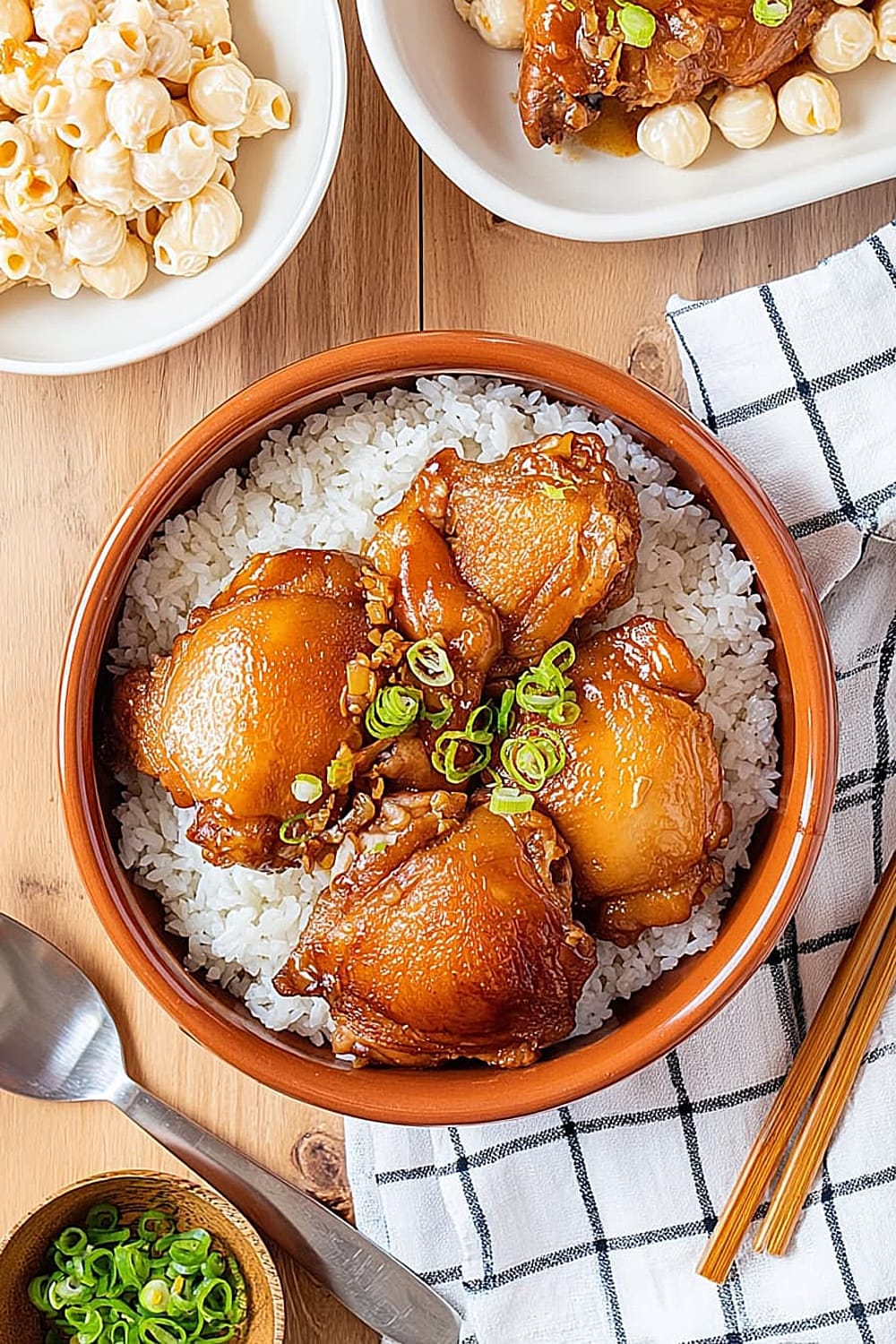
Sugar Substitutions:
- Replace 1/4 cup brown sugar with 2 tablespoons erythritol or 1 tablespoon stevia blend
- Monk fruit sweetener works excellently – use 2 tablespoons to replace the brown sugar
- The natural sugars in mirin provide sweetness, so you may need less substitute sweetener than expected
Carb Reduction Strategies:
- Serve over cauliflower rice instead of white rice to save approximately 35-40 grams carbs per serving
- Shirataki rice provides the texture of rice with virtually zero carbs
- Zucchini noodles or spaghetti squash make excellent low-carb bases for the sauce
Portion & Timing Tips:
- One chicken thigh with sauce contains approximately 8-12 grams carbs (mostly from the sauce)
- Pair with non-starchy vegetables like steamed broccoli or bok choy
- The high protein content helps stabilize blood sugar when eaten as part of a balanced meal
Total Carb Reduction: These modifications reduce carbs from 45-50 grams per serving to approximately 15-20 grams
Perfect Pairing Suggestions
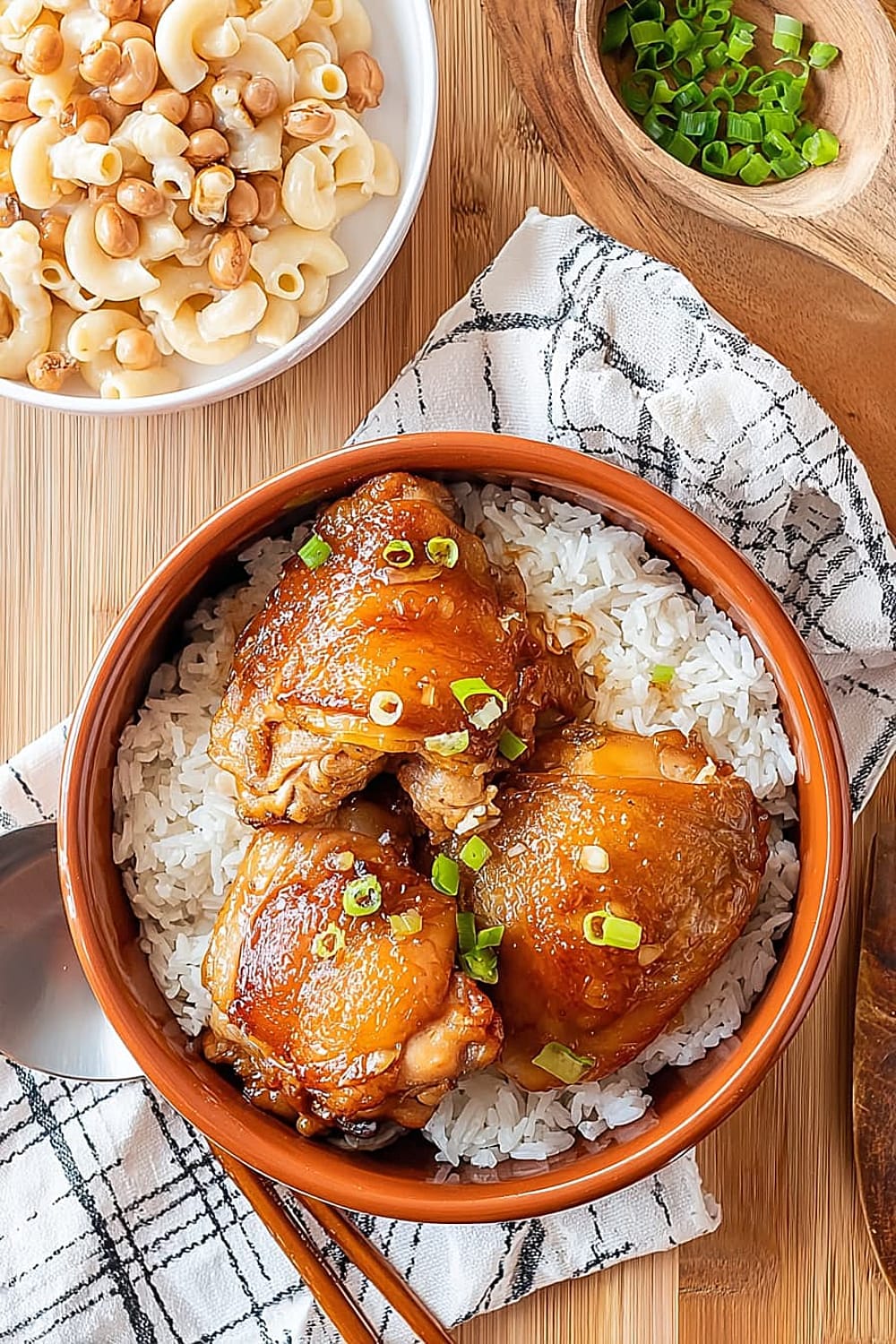
Beverage Pairings:
A crisp Riesling or Gewürztraminer complements the sweet-savory profile beautifully, while Pinot Noir pairs wonderfully with the rich, braised chicken. For beer lovers, Japanese lagers like Asahi or Sapporo echo the Asian flavors perfectly. Jasmine tea or oolong tea provide traditional non-alcoholic pairings that cleanse the palate between bites.
Side Dish Recommendations:
Steamed bok choy or gai lan with garlic adds fresh, slightly bitter greens that balance the rich sauce. Japanese cucumber salad with rice vinegar provides cooling crunch and acidity. Macaroni salad Hawaiian-style brings authentic plate lunch vibes, while grilled pineapple adds smoky sweetness that enhances the tropical theme.
Complete Meal Ideas:
Start with miso soup or wonton soup for an Asian-inspired progression. Add lumpia or gyoza as appetizers for a complete Pacific Rim experience. For dessert, mochi ice cream or haupia (coconut pudding) provides a light, refreshing finish that doesn’t compete with the rich main course.
Occasion Suggestions:
Perfect for casual family dinners and potluck gatherings where you want to impress without stress. Excellent for meal prep Sundays since it reheats beautifully throughout the week. The one-pot nature makes it ideal for camping trips with a Dutch oven or small kitchen cooking situations.
Pro Tips and Troubleshooting
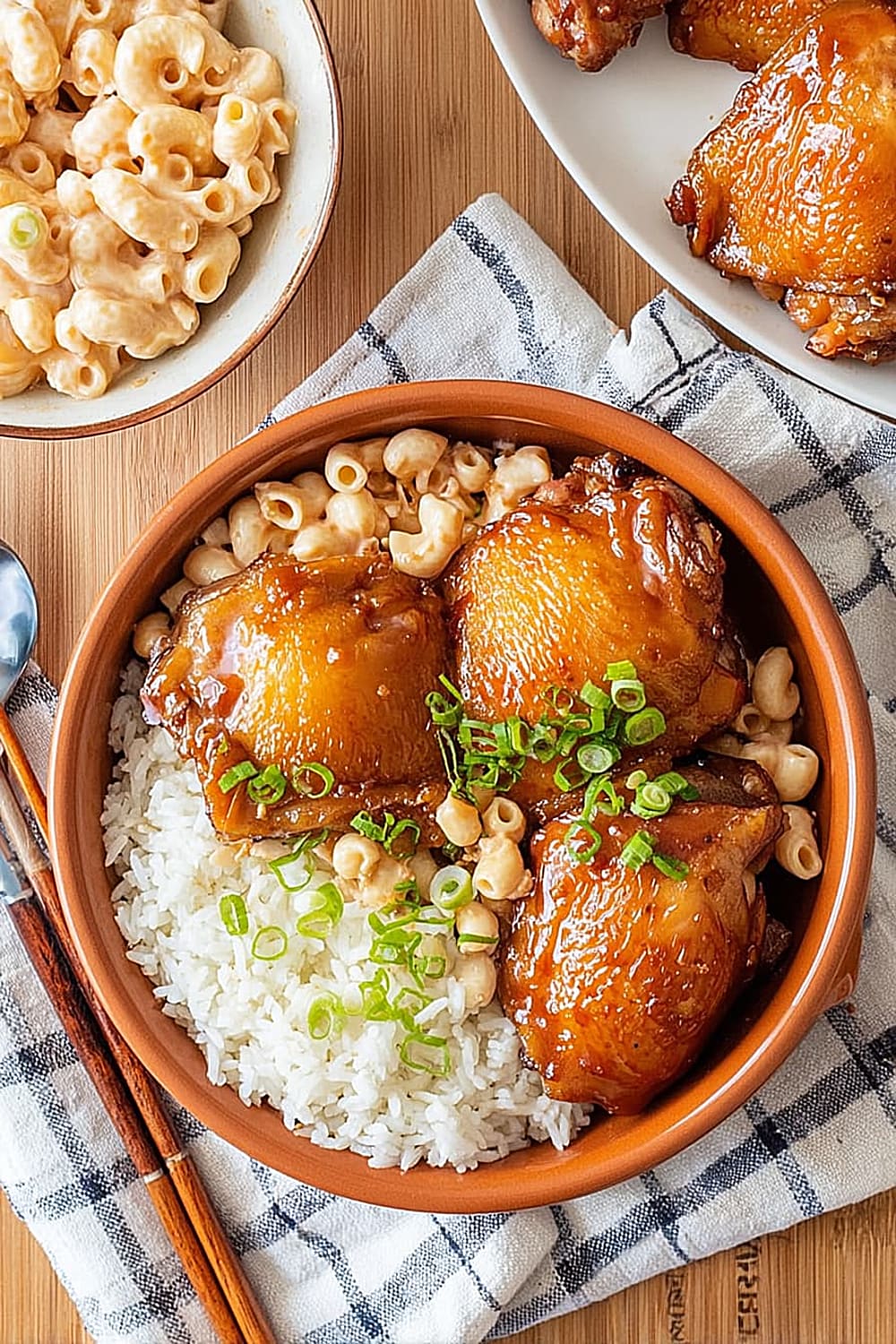
Professional Techniques:
Pat chicken thighs completely dry before adding to the pot – excess moisture dilutes the braising liquid and prevents proper browning. Don’t overcrowd the pot; cook in batches if necessary to maintain proper heat circulation. The sauce should reduce to about half its original volume for optimal flavor concentration and glossy appearance.
Common Mistake Prevention:
Resist the urge to flip the chicken during the first 30 minutes of covered cooking – this disrupts the rendering process and can result in tough, unevenly cooked meat. If your sauce reduces too quickly, add water 2 tablespoons at a time and adjust heat downward. Never boil vigorously, as this can make the chicken tough and cause the sauce to break.
Storage and Reheating:
Store leftovers in the refrigerator for up to 4 days in the braising liquid to maintain moisture. Reheat gently in a covered pan over low heat for 8-10 minutes, adding a splash of water if needed. The dish freezes well for up to 3 months – thaw overnight in refrigerator before reheating.
Make-Ahead Strategy:
This recipe actually improves overnight as flavors meld. Cook completely, cool, and refrigerate. Reheat the next day for even better flavor. You can also prep all ingredients the morning of cooking and combine them when ready to start the braising process.
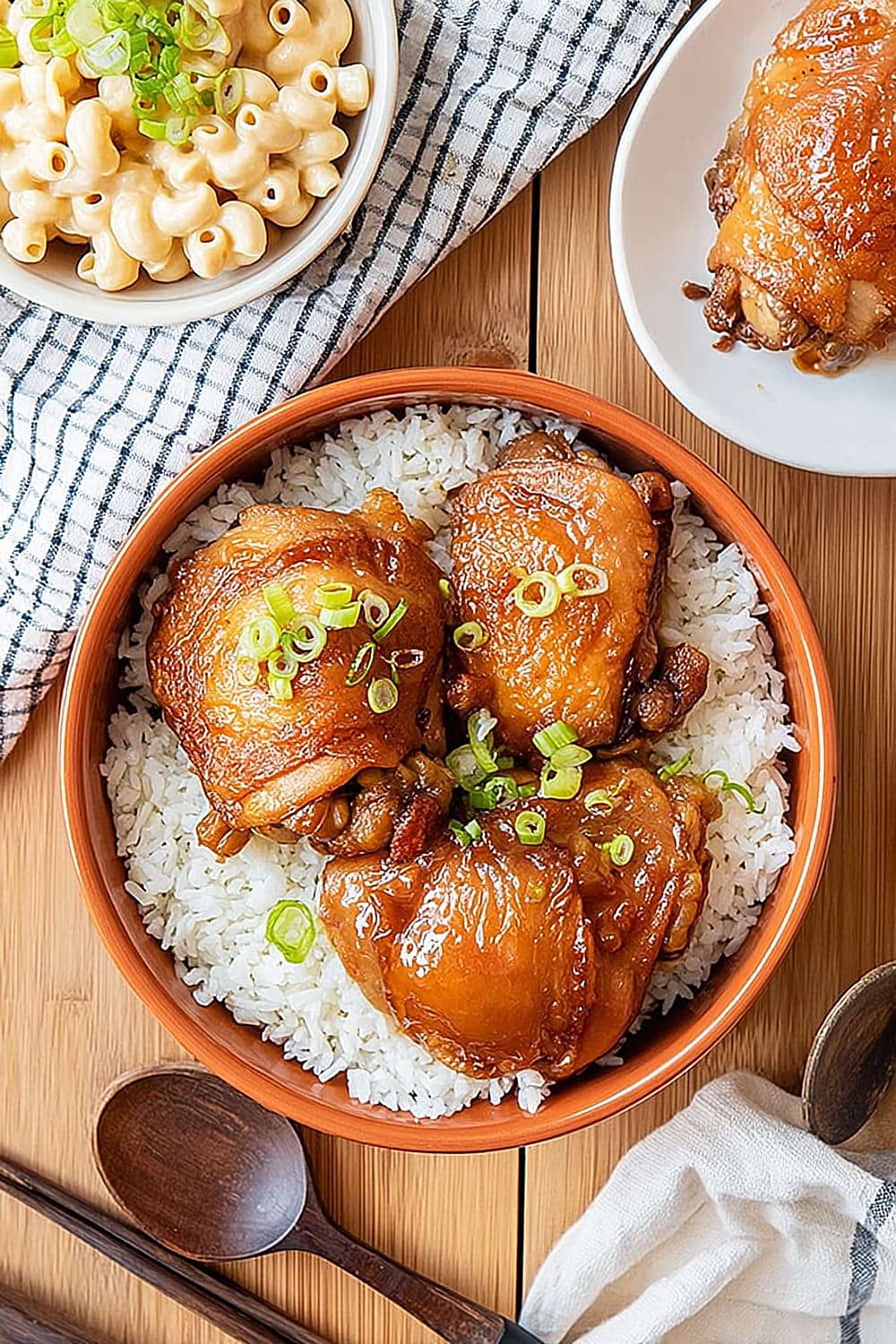
Whether you’re craving authentic Hawaiian comfort food or just want to transform ordinary chicken into something extraordinary, this shoyu chicken delivers restaurant-quality results with minimal effort. The tender, fall-off-the-bone chicken paired with that glossy, umami-rich sauce creates the kind of meal that turns a regular Tuesday into something special – and isn’t that exactly what good cooking should do?